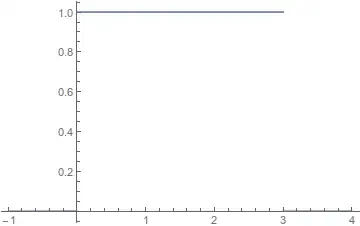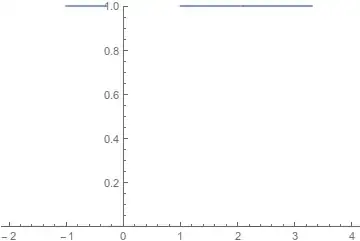Here is the way I like to think of this. Whenever I try to gain intuition about integration, I always boil it down to step functions since the results extend nicely from there and step functions are oh-so-easy to work with. This is a good technique that can be used to visualize many of the standard identities from calculus and gain some intuition about them.
Let's then consider characteristic function $\chi_{[a,b]}$ and see what happens under this transformation. Well
$$ \chi_{[a,b]}\left(x-\frac{1}{x}\right) = \begin{cases} 1, & x-\frac{1}{x}\in [a,b] \\ 0, & x-\frac{1}{x}\not\in[a,b]\end{cases}$$
For area purposes, it's best to have a function simply of $x$, not $x-\frac{1}{x}$ which means that we need to consider what the inverse image of $[a,b]$ is.
For now, let's suppose that $0 < a < b$. Then the inverse image of $[a,b]$ under $f(x) = x-\frac{1}{x}$ is nothing more than
$$\left[\frac{b-\sqrt{b^2+4}}{2},\frac{a-\sqrt{a^2+4}}{2}\right]\bigcup \left[\frac{a+\sqrt{a^2+4}}{2},\frac{b+\sqrt{b^2+4}}{2}\right].$$
This can be verified quite simply by noting that for the range of $0 < a < b$, $x-\frac{1}{x}$ is monotone on its preimage. With that in mind, it becomes clear that
$$ \chi_{[a,b]}\left(x-\frac{1}{x}\right)(x) = \chi_{[\frac{b-\sqrt{b^2+4}}{2},\frac{a-\sqrt{a^2+4}}{2}]\bigcup [\frac{a+\sqrt{a^2+4}}{2},\frac{b+\sqrt{b^2+4}}{2}]}(x).$$
The area under this characteristic function is then just
$$ \left(\frac{a-\sqrt{a^2+4}}{2} - \frac{b-\sqrt{b^2+4}}{2}\right)+\left(\frac{b+\sqrt{b^2+4}}{2}-\frac{a+\sqrt{a^2+4}}{2}\right) = b-a$$
which is nothing more than the area under $\chi_{[a,b]}$. A very similar analysis can be done for the case of $a < b < 0$ and then it can be extended quite easily to all $[a,b]$. Here are some plots with $a = 0, b = 3$:
$\chi_{[0,3]}$:

$\chi_{[\frac{3-\sqrt{13}}{2},-1]\cup[1,\frac{3+\sqrt{13}}{2}]}$:

As you can see, we have a nice splitting of the interval into two pieces and if you roughly estimate the area, it does indeed come out to $3$ as expected.
Moreover, it's not hard to see that the choice of $\alpha$ (playing the role of your $a$) is not of consequence here since by employing the quadratic equation, the $\alpha$ would only appear inside the square roots. As such, it would cancel when you evaluate the area.

